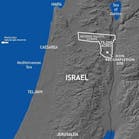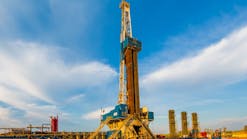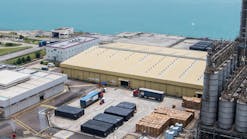Anne K. Rhodes
Refining/Petrochemical Editor
With 1.1 million b/d of refining capacity, Singapore is the world's third largest concentrated refining center, trailing only the U.S. Gulf Coast and Rotterdam areas (Fig. 1)(139031 bytes).1 But space on the island is limited and land is expensive.
Despite these restrictions, two of Singapore's major refiners have found ways to expand their operations.
Singapore Refining Co. Pte. Ltd. (SRC) is completing a major expansion project, set to come on stream this fall. And Mobil Oil Singapore Pte. Ltd. brought on stream a new UOP continuous catalytic reformer (CCR) and aromatics complex in January 1994.
SRC
Singapore Refining Co. operates a 225,000 b/d refinery on the island of Pulau Merlimau, which is off the main island (Fig. 1).
SRC was formed in 1979 as a joint venture of Singapore Petroleum Co., BP, and Caltex Petroleum Corp. Prior to its formation, Singapore Petroleum Co. operated the refinery, which started up in 1973.
SRC calls its plant the first true joint venture refinery in the area, meaning it was formed to process feedstocks for the individual partners. The SRC refinery processes more than 20 different crudes, making it a "cocktail refinery." Its typical crude slate is 90% Middle Eastern and 10% Far Eastern crudes.
Although each partner owns a one-third share in the refinery, ownership of the individual units varies according to marketing requirements. For example, BP and Caltex each own 41.7% of the catalytic reformer -- a gasoline producing unit. Singapore Petroleum Co., which sells less gasoline than the other two partners, owns only 16.6% of the reformer.
Products
Transportation fuel demand in Southeast Asia centers around diesel fuel, which is a major product for Singapore's refiners. SRC's typical product slate, before the RCC project, includes only 6% motor gasoline and 26% diesel.
When SRC brings on line the resid catalytic cracking (RCC) unit that is the center of its upgrade project, the refinery will be capable of producing diesel containing 0.1% sulfur, or as low as 0.05%, if required.
Most of the gasoline produced at the SRC refinery is unleaded, because tax structures in Singapore and Malaysia discourage use of leaded gasoline. Naphtha from the refinery is sent via pipeline to Singapore Petrochemical Co. Pte. Ltd.'s ethylene plant on nearby Pulau Ayer Merbau.
Sulfur is sold to sulfuric acid and fertilizer producers as feedstock. Much of the refinery's output of asphalt is exported to Viet Nam for road construction.
Other refinery products include LPG, jet fuel, fuel oil, and carbon dioxide.
Expansion project
The RCC project is now in the completions phase at the SRC refinery. This project will almost double the complexity of the refinery, according to project manager Jack Bradie.
Project goals included:
- Upgrading resid to distillates
- Increasing unleaded gasoline production
- Increasing low-sulfur diesel output.
The project emphasizes a 24,000-33,000 b/sd (depending on feed) RCC unit. The unit is licensed from Stone & Webster Engineering Corp., with a catalyst cooler designed by the Beijing Design Institute.
Feed for the RCC unit will include: atmospheric resid from an existing crude unit and from a new 60,000 b/sd crude unit; heavy vacuum gas oil; and low-sulfur fuel oil from the refinery's existing hydrocracker.
Also included in the RCC project are:
- A 1,400 b/sd methyl tertiary butyl ether (MTBE) unit (licensed by Catalytic Distillation Technologies Inc.)
- A 4,500 b/sd sulfuric acid alkylation unit (Stratco Inc. license)
- A 45 ton/day sulfuric acid regeneration unit (Simon Carves Ltd. license)
- A 40,000 b/sd hydrotreater
- A Dimersol unit (3,600 b/sd C3 feed and 600 b/sd C4 feed, licensed from Institute Franais du Petrole)
- An 18 MMscfd hydrogen unit (Haldor Topse A/S license)
- An 80 ton/day sulfur recovery plant (Comprimo license)
- A 190 ton/hr amine unit
- An 8,000 b/sd C3/C4 splitter
- A 4,200 b/sd propylene upgrading unit
- Two UOP Merox units (9,300 b/sd RCC LPG feed and 8,000 b/sd crude unit LPG feed).
The refinery flow diagram, post RCC project, is shown in Fig. 2(102817 bytes).
As part of the project, SRC is adding Phase 1 of a new effluent treatment facility, which will tie in with the existing refinery units and provide basic biotreatment. Phases 2 and 3 will include enhanced oil removal, conventional activated sludge biotreatment, and sludge handling facilities.
In addition, three existing sulfur plants are being debottlenecked and one is being revamped. SRC also included, as part of the RCC project, provisions for adding a NOx-removal system in the future.
Two 600,000-bbl crude tanks were installed to supply the additional 60,000 b/d of crude capacity. This brings the refinery's crude storage capacity to 5.6 million bbl.
In addition to construction of those tanks, SRC built two methanol storage tanks, one kerosine tank, five gasoline tanks, one propylene sphere, and two butane bullets.
Construction
SRC reclaimed two parcels of land -- more than 15 hectares (37 acres) total -- to build the complex. Even with this addition, the process layout had to be designed carefully to accommodate the new units, and the basins of two new crude tanks had to be used as the laydown area for construction.
After reclamation, Japan's JGC Corp. took over, building the RCC project under a lump sum contract worth about $US840 million. A four-story floating hotel is docked at the island to house contract workers.
JGC has already handed over the utility units to SRC. These include a fourth 100 ton/hr boiler, a 7,800 cu m/hr sea water cooling system, and a new flare stack. The remainder of the units are expected to be in SRC's hands by Sept. 15, only 32 months after project design began.
Shipments
The SRC refinery's feedstock is supplied via one of only three single-point mooring (SPM) systems in Singapore. This SPM can handle very large crude carriers up to 320,000 dwt. The refinery is connected to the SPM via a 9-km, 48-in. diameter underwater pipeline.
SRC aso has six jetties on the island. As a result of the expansion, however, the company is considering adding two additional jetties.
Mobil
Mobil Oil Singapore operates a 250,000 b/cd refinery at Jurong (Fig. 1). The refinery, built on swampland, started up in 1967.
Mobil's Jurong complex is the company's largest wholly owned refinery outside the U.S. It operates as a swing refinery for Mobil's operations in the Asia/Pacific region, in addition to processing oil for third parties under term or spot processing agreements.
General Manager of Manufacturing G.L. Kohlenberger says Singapore's excellent infrastructure and skilled workforce, combined with government cooperation, make it an attractive place to operate a refinery.
Configuration
The Mobil refinery has two crude units: No 1, with about 45,000 b/d of capacity, and No. 2, with about 210,000 b/d. Additional preflash capacity, installed in late 1994, enables Mobil to process more condensates, which means the refinery can run as much as 260,000 b/sd of crude.
The refinery configuration includes:
- 90,000 b/d of vacuum distillation capacity
- 55,000 b/d visbreaking
- 23,000 b/d medium-pressure hydrocracking
- 58,000 b/d of catalytic reforming capacity (with pretreating)
- Two gas oil hydrodesulfurization units (total capacity 48,000 b/d)
- Two kerosine Merox units (about 40,000 b/d total)
- An 11,000 b/d Mobil isomerization/dewaxing unit.
The refinery's crude slate averages 32 API and 1.7% sulfur. Typical composition is 80% Persian Gulf sour oil and 20% Southeast Asian light, sweet crude.
The product slate is weighted toward distillates, all of which are desulfurized except fuel oil. Kohlenberger says, given regional economics, kerosine and distillate often command better premiums than unleaded gasoline.
The refinery exports products to Guam, Hong Kong, and other Southeast Asian countries, including Malaysia, Thailand, and the Philippines. Resid and a small percentage of the plant's white products are sold in Singapore.
Because the refinery's products are largely for export, many regional specifications must be met. The refinery's 30,000 b/d of gasoline production comprises as many as 20 different grades.
Specifications for other products also are varied. For example, Thailand and Hong Kong require a lower gas oil 90% point to reduce particulate emissions.
The refinery's new high-pressure gas oil hydrotreaters enable Mobil to produce low-sulfur (0.05%) diesel. Although Hong Kong has a 0.2% sulfur specification now, it is going to a 0.05% spec in 1997. Japan also is reducing its specification to 0.05%, but in 1996.
To meet the variety of specifications, in-line blending is essential, as is a lot of tankage. Some of Mobil's tanks are located on nearby Pesek Island.
To make room for the new tanks required when Mobil built its aromatics complex, 23 hectares (57 acres) of land had to be reclaimed at Pesek. Eleven storage tanks and three LPG spheres were constructed on the island, and 18 aromatics products tanks were added at Jurong.
Before the expansion, the refinery's shipping facilities included six berths handling tankers of as much as 100,000 dwt, and a deepwater single-buoy mooring (SBM) system for supertankers as large as 285,000 dwt. Mobil shares the SBM with Esso Singapore Pte. Ltd.
As part of the aromatics expansion, a seventh berth was added to accommodate ships as large as 85,000 dwt.
Aromatics complex
Ownership of the refinery's new aromatics complex is split evenly between Mobil Singapore and Mobil Chemical Co. The aromatics complex comprises:
- A 38,000 b/d (charge capacity) UOP CCR unit that can produce 30,000 b/d of reformate
- A UOP Sulfolane unit, with production capacity for 175,000 ton/year (t/y) benzene and 45,000 t/y toluene
- A Mobil High Activity Isomerization (MHAI) unit and UOP Parex unit that, together, have 275,000 t/y para-xylene production capacity (The unit also makes ortho-xylene, mixed xylenes, and other aromatics.)
- A 150,000 t/y cyclohexane unit.
Total aromatics capacity of the complex is 575,000 t/y. A simplified flow diagram of the new complex is shown in Fig. 3(68023 bytes).
Feed for the aromatics unit is reformate from the new CCR and the existing 20,000 b/d semiregenerative platinum reformer. The benzene and toluene in the reformate are extracted in the Sulfolane unit, then fractionated to produce 99.9% purity benzene and 99.8% purity toluene.
The Parex unit separates para-xylene from other xylenes and nonaromatic hydrocarbons via adsorption. Parex feed is eight-carbon reformate from the xylene splitter. The remaining reformate is blended into gasoline.
The CCR unit increases gasoline production from the refinery by about 17,000 b/d, after aromatics are extracted from the reformate.
Although he declined to reveal specific plans, Kohlenberger said Mobil would like to increase crude capacity, aromatics capacity, and possibly add some lube oil production.
Industry expansion
Although space is limited in Singapore, the country's refiners say the government is friendly toward industry. One reason is that the government deals with industry on a market-related basis. Refiners are invited to comment on regulations, and tax incentives are provided for projects that enhance the overall competitiveness of the republic.
It is because of this business climate that the island nation's refiners are optimistic about future operations.
BP is closing its 28,000 b/d Singapore refinery -- the country's smallest -- in the second half of this year. The facility will be converted to a storage terminal.
Despite this minor reduction in capacity, Singapore's refiners are confident about expansion possibilities. In fact, Kohlenberger believes the two projects described in this article, and a new aromatics complex currently under construction at Esso Singapore Pte. Ltd.'s refinery, are at the forefront of a regional upgrading program.
As a case in point, the Singaporean government plans to join seven islands off Singapore's coast into what it calls a "chemical island." The "finished" island is to be named Jurong Island, and will include Merlimau, Seraya, Ayer Merbau, Sakra, Ayer Chawan, Pesek, and Pesek Kertih Islands.
The project will take 15-20 years to complete and will triple the area occupied by the country's processing industry (now about 1,000 hectares). Included in this US$4 billion project is land reclamation and construction of a road connecting the main island to the chemical island.
Reference
1.Williamson, Michelle, "Worldwide Refining Survey," Oil & Gas Journal, Dec. 19, 1994, p. 85
CORRECTION
Alton Meyer's "Texas gathering system's scada evolved over 14 years" (July 10, p. 51) failed to indicate that the article was based on a presentation to Entelec '95, Apr. 2-5, Houston.
Copyright 1995 Oil & Gas Journal. All Rights Reserved.


